VMware ESXi 7.0 Installation and Basic Configuration
VMware vSphere is the pioneer in virtualization world. No other virtualization software is as feature rich as VMware vSphere. More than 500,000 enterprise data center are now using VMware vSphere. It is expected that most of the data center will be turned into virtualization in near future. As VMware vSphere provides more feature than any other virtualization software, it is also expected that demand of VMware vSphere will increase day by day. VMware ESXi is the foundation of VMware vSphere and current release version of VMware vSphere is ESXi 7.0. So, in this article, I will discuss how to install VMware ESXi 7.0 hypervisor step by step with screenshot. We will also see how to configure management network for accessing VMware ESXi Host from VMware web console.
Hardware Requirements for VMware ESXi 7.0
VMware ESXi requires system planning before installation. So, think your data center and arrange server hardware according to your requirements. Here, I am only mentioning the minimum requirements to install VMware EXSi 7.0 hypervisor. Hardware and system resources must meet the following requirements to start VMware ESXi 7.0 installation.
- Supported server platform. See the VMware Compatibility Guide to check server platform.
- Host machine must have at least two CPU cores.
- ESXi 7.0 supports 64-bit x86 processors released after September 2006. This includes a broad range of multi-core processors.
- The NX/XD bit to be enabled for the CPU in the BIOS.
- Minimum 4 GB physical RAM. It is recommended to provide at least 8 GB of RAM to run virtual machines properly.
- To support 64-bit virtual machines, hardware virtualization (Intel VT-x or AMD RVI) must be enabled on x64 CPUs.
- One or more Gigabit or faster Ethernet controllers. For a list of supported network adapter models, see the VMware Compatibility Guide.
- SCSI disk or a local, non-network, RAID LUN with unpartitioned space for the virtual machines.
- ESXi 7.0 requires a boot disk of at least 8 GB for USB or SD devices, and 32 GB for other device types such as HDD, SSD, or NVMe. A boot device must not be shared between ESXi hosts.
- For Serial ATA (SATA), a disk connected through supported SAS controllers or supported on-board SATA controllers. SATA disks are considered remote, not local. These disks are not used as a scratch partition by default because they are seen as remote.
If we have the above minimum requirements, we are ready to install VMware ESXi 7.0. In the following section, we will see how to install VMware ESXi 7.0 step by step with screenshots.
VMware ESXi 7.0 Installation Step by Step with Screenshots
We will now install VMware ESXi 7.0. We can easily install VMware ESXi following the below three steps:
- Downloading VMware ESXi Hypervisor or VMvisor ISO and making bootable drive
- Executing VMware ESXi installation process
- Configuring VMware ESXi Management Network
Step 1: Downloading VMware ESXi VMvisor ISO and Making Bootable Drive
Before going to start VMware ESXi installation, we have to collect VMware VMvisor ISO file from VMware download page and then burn this ISO to a bootable CD/DVD. The following steps will show how to download VMvisor ISO file and how to burn ISO file to a bootable CD/DVD.
- Go to VMware official site [vmware.com] and click on Download menu item and then click on vSphere option. To download any products from VMware, you need to register or sign up to VMware. So, if you don’t have any account in VMware, create an account now. VMware only allows software download for the licensed user. So, if you don’t buy any license, register VMware ESXi downloads for trial (60 days only) and then download VMware VMvisor ISO file. Alternatively, you can search VMware ESXi license in ebay and if you have good luck can get license there with cheap price and can be able to download VMvisor ISO file from provided link there after purchasing license.
- After downloading ISO file, burn the ISO image in a CD or DVD with your favorite burning software such as Nero [nero.com] or Power ISO [poweriso.com] and then insert the burnt CD/DVD in Physical Server’s CD/DVD ROM.
Step 2: Executing VMware ESXi Installation Process
After inserting CD/DVD in Server’s DVD ROM, we will now start VMware ESXi 7.0 installation. So, press power button of server machine and go to boot option menu according to server machine vender. Choose boot from CD/DVD ROM and system will start booting from CD/DVD and VMware ESXi installer will start loading.
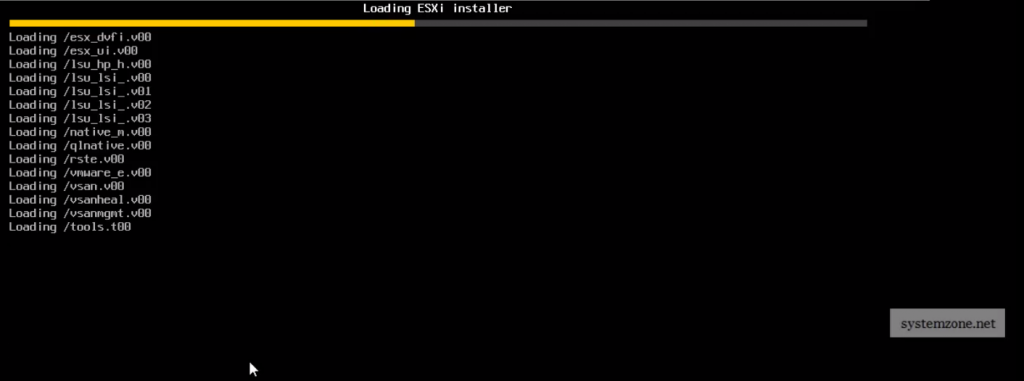
After loading all modules successfully, ESXi installer will ask to start installation process. In this window, we have nothing to do. Just press Enter key to start ESXi installation.
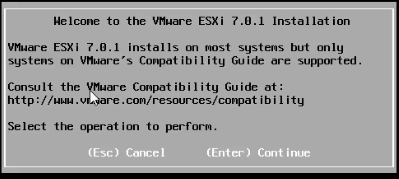
After pressing Enter key ESXi installer will ask to accept VMware End User License Agreement. Without accepting license agreement, we will not be able to start installation. Press F11 key to accept license agreement and continue the installation process.
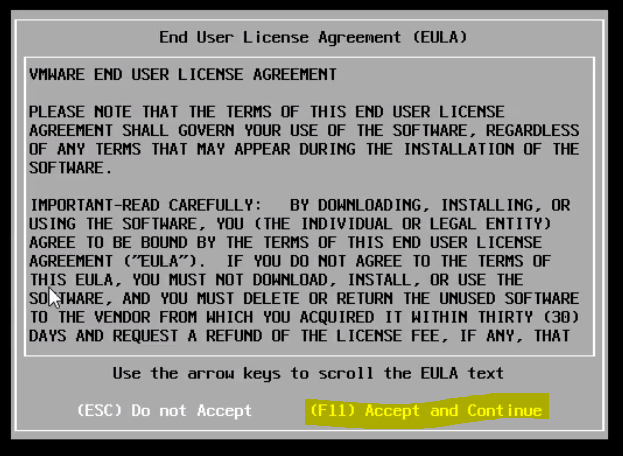
After accepting VMware end user license agreement, ESXi installer will start to scan available storage devices (HDD) attached with the Host Server. This process may take some times depending on attached storage devices.
After scanning storage devices ESXi installer will show available storage devices as summery. Here, we will find two types of storage devices – Local and Remote. Local storage devices are those which are directly attached with the host such as Host’s own HDD. Remote storage devices are LUN HDDs those are attached from array devices such as DELL EMC Storage Array.
Besides showing available storage devices, ESXi installer will ask to choose a storage device (HDD) where ESXi will be installed. So, choose the HDD from the list where you want to install VMware ESXi and then press Enter key to go to next step.
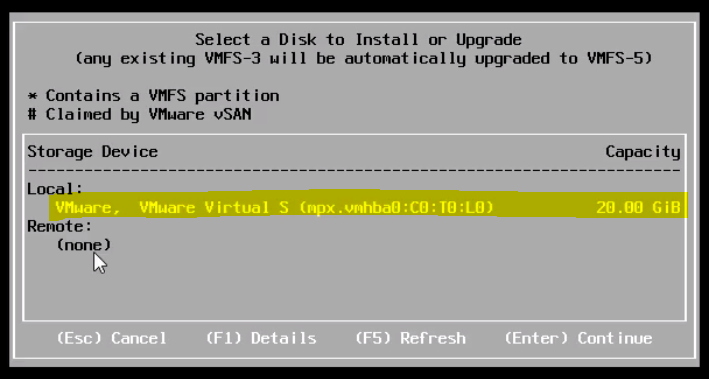
After choosing HDD for ESXi installation and pressing Enter key, ESXi installer will ask to choose keyboard layout that will be used to input from your keyboard. By default ESXi installer will select the US default keyboard layout. It will be better to keep the default one but if you wish can change the keyboard layout what you want. After selecting chosen keyboard layout, press Enter key to continue to the next step.
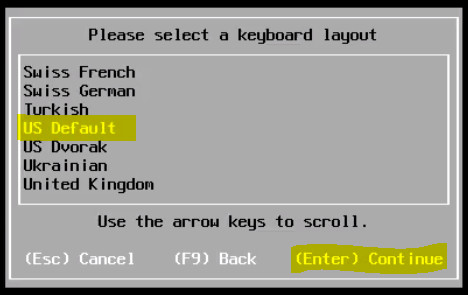
Now ESXi installer will ask to put root password. Carefully put root password and confirm the password. Never forget the root password until changing the new root password. Password must be at least 7 characters. After providing root password, press Enter key to continue the next step.
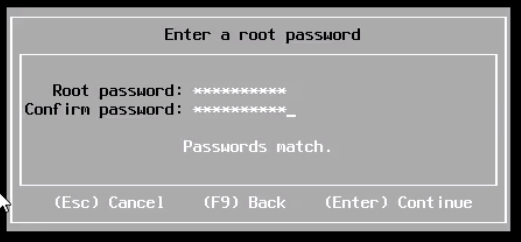
After providing root password, ESXi installer will gather some additional system information which may take a few moments and then it will ask to confirm installation because it will format and repartitioned the selected disk space and old data can never be retrieved. Press F11 key to confirm ESXi installation.
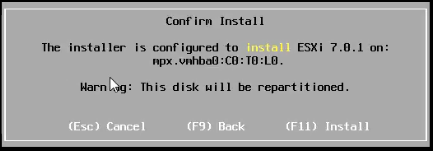
After confirming installation, ESXi installation will be started and we can see the progress of installation on the screen. VMware ESXi is s so light operating system. So, it will take a few moments to install ESXi OS on host machine.

VMware ESXi installation will be completed within a few moments and a successful message will be shown. It will also ask to reboot the server to start using VMware ESXi. But before reboot the server, make sure the installation media (CD/DVD) has been removed. Press Enter key to reboot the server.
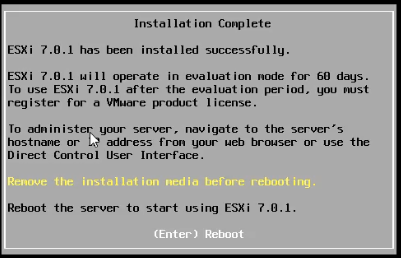
Host Server will be shut down and reboot and it will take short time to complete these processes. After rebooting, VMware ESXi will start loading and the home screen of VMware ESXi will be displayed after loading all ESXi modules.
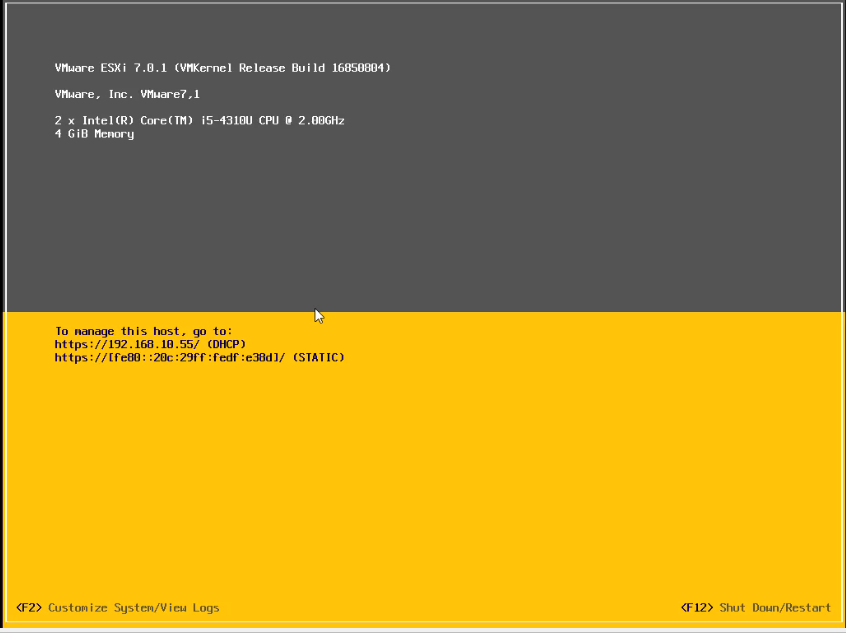
If the server network adapter is connected to a DHCP server, an IP will be assigned on Management Network dynamically and the IP will be shown on ESXi home screen. In the above home screen, we can see that an IP has been assigned dynamically.
If we don’t want to keep this dynamically assigned IP address, we can also assign management IP address statically. We will see how to assign static management IP address as well as DNS and Hostname from home screen in the following step.
Step 3: Configuring VMware ESXi 7.0 Management Network
After VMware ESXi 7.0 installation, the first post installation task is assigning static IP address on management network. Although management IP can be assigned dynamically, most network administrators do not like assigning IP address dynamically on ESXi management network. So, we will now see how to configure management network from VMware ESXi home screen.
On the ESXi home screen, shown in above image, press F2 for Customize System/View Logs. Enter the root password that was provided in installation process in the prompted window and then press Enter key. System Customization menu will appear now.
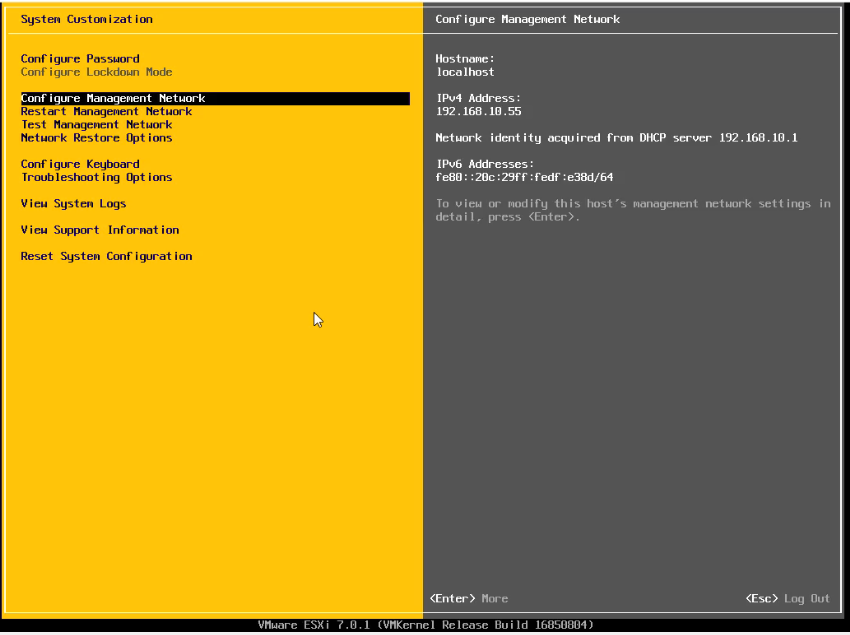
From the System Customization menu, select Configure Management Network and then press Enter key. Configure Management Network menu will appear.
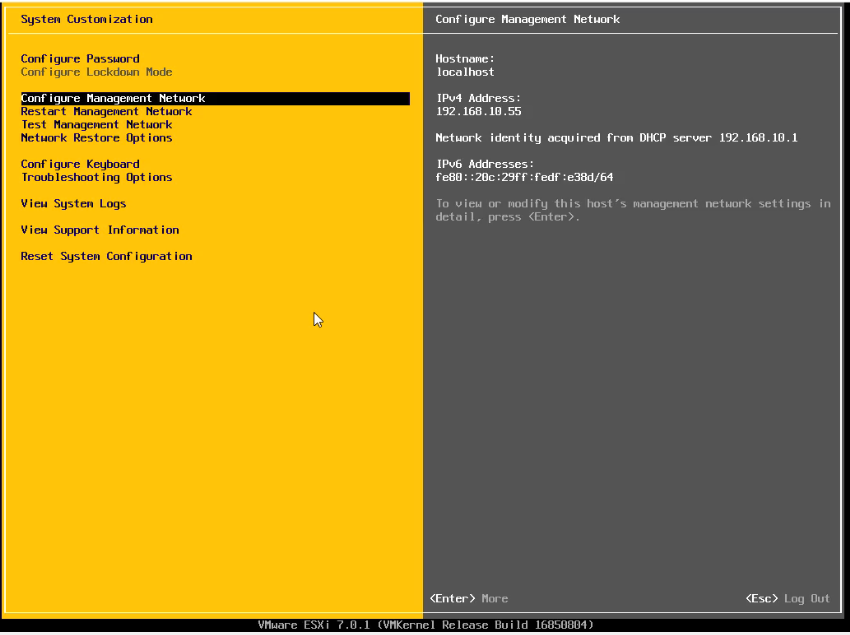
From the Configure Management Network menu, select IPv4 Configuration menu item and press Enter key. IPv4 Configuration window will appear.
From IPv4 Configuration window, select Set static IPv4 address and network configuration option using up and down key and then press Space key to make it selected.
Now set preferred IPv4 Address, Subnet Mask and Default Gateway statically and then press Enter key.
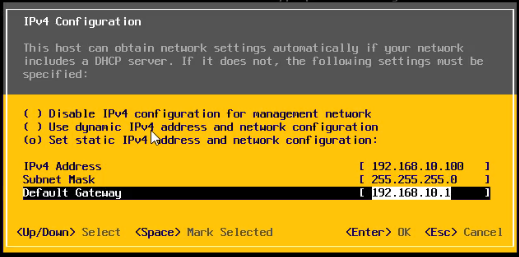
To configure DNS and Hostname, select DNS Configuration menu item from the Configure Management Network menu and then press Enter key. DNS Configuration window will appear.
From DNS Configuration window, select Use the following DNS server addresses and hostname option using up and down key and then press Space key to make it selected.
Now provide Primary DNS Server, Alternate DNS Server address and Hostname and then press Enter key.
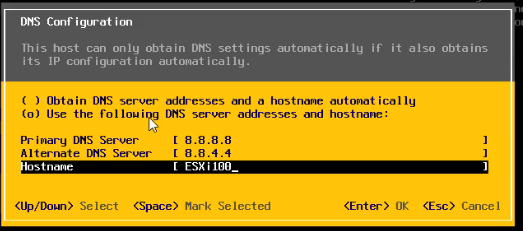
Now press Esc key to return from Configure Management Network. It will now ask to confirm to apply the management network changes. Press Y key to apply changes and restart management network.
After applying changes, Configure Management Network menu will return to System Customization menu. From System Customization menu, press Esc key to log out from System Customization and return to ESXi home screen.
Now go to any PC from where ESXi management IP address is accessible and open any web browser. I personally suggest using Google Chrome because it is so easy and comfortable. But you can use any browser what you preferred.
Type the URL shown in ESXi home screen (example: https://ESXi_IP_address) in browser’s URL bar and press Enter key. As ESXi uses self-signed SSL certificate, browser may not trust this certificate and it will show a warning message that the certificate is not trusted. In this case, click on Advanced button shown in the appeared page and then click the link saying Processed to ESXi_IP_address (unsafe). Now you will find the VMware ESXi login page like the below image.
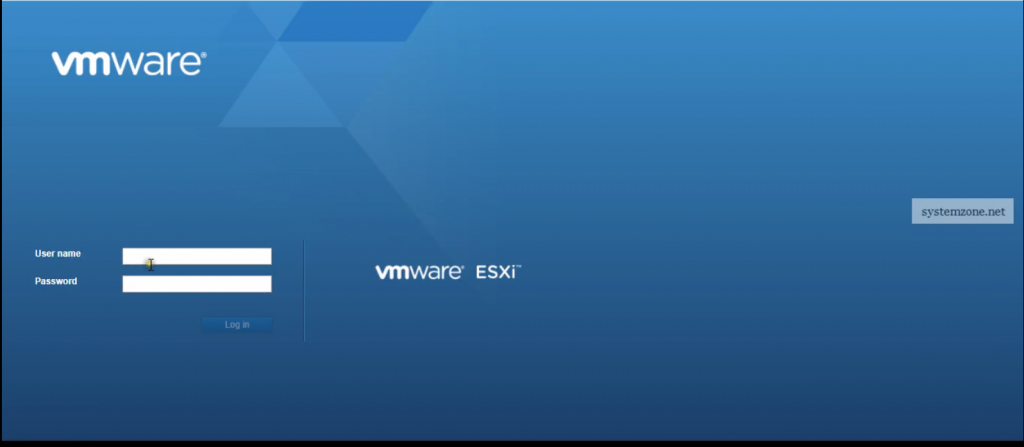
In the login page, put User name root and put the root password in Password input field and then press Enter key or click on Log in button. Now you will find the VMware ESXi web administration page from where we can manage everything to run a smooth data center with VMware ESXi.
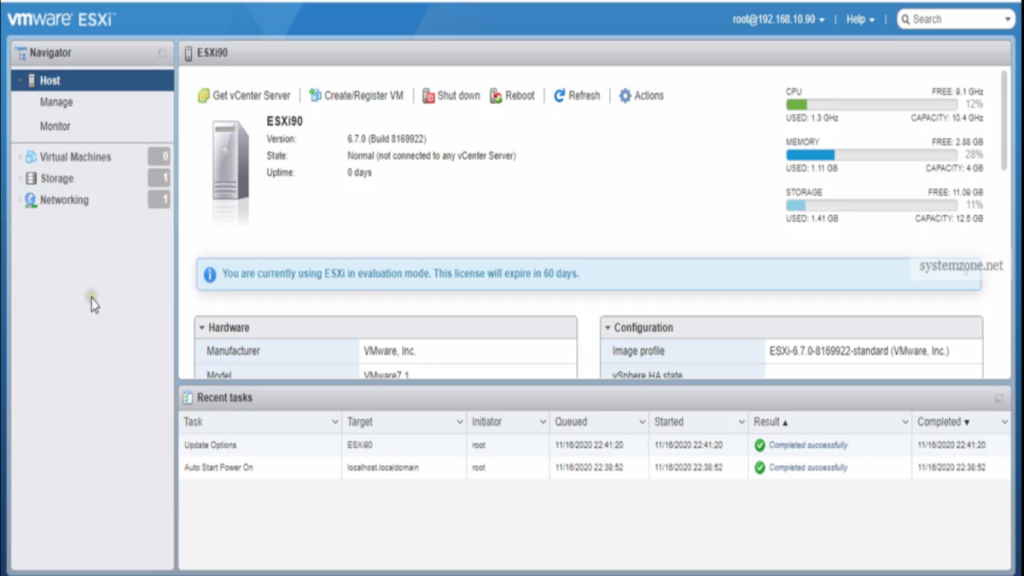
How to install VMware vSphere 7.0 and how to configure its management network has been discussed in this article. I hope you will now be able to install VMware vSphere on your physical server properly. However, if you face any confusion to install and configure VMware ESXi properly, feel free to discuss in comment or contact me from Contact page. I will try my best to stay with you.
Why not a Cup of COFFEE if the solution?


Hi
This is Nirmalachandan from Andhra Pradesh and
nirmalachandantechnologi@gmail.com is my email address
Please can u guide me in installing ESXi 7.0 and Vcentral SErver in my systems
My contact number is 9440105643
Thanking you sir
Nirmalachandan
Can contact over whatsapp: +8801737325759